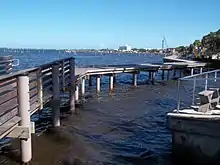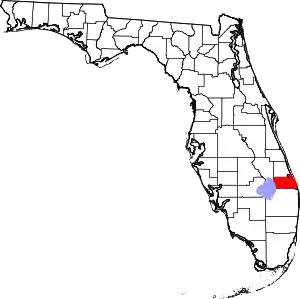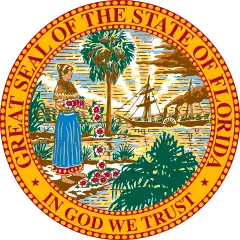Stuart, Florida
Stuart is a city in and the seat of Martin County, Florida, United States. Located on Florida's Treasure Coast, Stuart is the largest of four incorporated municipalities in Martin County. The estimated population is 16,237 according to the most recent United States census estimates. Stuart is the 126th largest city in Florida based on official 2019 estimates from the US Census Bureau.[5] It is part of the Port St. Lucie, Florida Metropolitan Statistical Area.
Stuart, Florida | |
|---|---|
 Downtown Stuart | |
| Nickname(s): Sailfish Capital of the World | |
 Location in Martin County and the state of Florida | |
| Coordinates: 27°11′32″N 80°14′35″W | |
| Country | United States |
| State | Florida |
| County | Martin |
| City | 1914 |
| Government | |
| • Type | Commission-Manager |
| • Mayor | Michael J Meier |
| • Vice Mayor | Eula Clarke |
| Area | |
| • Total | 9.38 sq mi (24.28 km2) |
| • Land | 7.01 sq mi (18.16 km2) |
| • Water | 2.36 sq mi (6.12 km2) |
| Elevation | 10 ft (3 m) |
| Population (2010) | |
| • Total | 15,593 |
| • Estimate (2019)[2] | 16,237 |
| • Density | 2,315.27/sq mi (893.95/km2) |
| Time zone | UTC−5 (Eastern (EST)) |
| • Summer (DST) | UTC−4 (EDT) |
| ZIP codes | 34994-34997 |
| Area code(s) | 772 |
| FIPS code | 12-68875[3] |
| GNIS feature ID | 0291756[4] |
| Website | City of Stuart Website |
Stuart is frequently cited as one of the best small towns to visit in the U.S., in large part because of its proximity to the St. Lucie River and Indian River Lagoon.[6][7]
History
In the 18th century, several Spanish galleons were shipwrecked in the Martin County area of Florida's Treasure Coast. The multiple wrecks were reportedly the result of a hurricane, and the ships were carrying unknown quantities of gold and silver. Some of this treasure has since been recovered, and its presence resulted in the region's name.

In 1832, pirate Pedro Gilbert, who often used a sandbar off the coast as a lure to unsuspecting prey, chased and caught the Mexican, a U.S. merchant ship. Although he attempted to burn the ship and kill the crew, they survived to report the incident, ultimately resulting in the capture and execution of Gilbert and his crew. The bar from which he lured his intended booty is named "Gilbert's Bar" on nautical charts.[8][9]:1

The Treasure Coast area that became Stuart was first settled by non-Native Americans in 1870. In 1875, a United States Lifesaving Station was established on Hutchinson Island, near Stuart. Today, the station is known as Gilbert's Bar House of Refuge and is on the National Register of Historic Places.
From 1893 to 1895, the area was called Potsdam. This name was chosen by Otto Stypmann, a local landowner originally from Potsdam, Germany. Stypmann, with his brother Ernest, owned the land that would become downtown Stuart. Henry Flagler's Florida East Coast Railway connected the area to Daytona Beach in 1892 and Miami in 1896.
Potsdam was renamed Stuart in 1895, in honor of Homer Hine (Jack) Stuart Jr., a local landowner who owned a 160 acres around the railway station.[9]:7 Rue, Luckhardt, Krueger, Crary, Armellinis, were some of the prominent settler families.[10]
When Stuart was incorporated as a town in 1914, it was located in Palm Beach County. In 1925, Stuart was chartered as a city and named the county seat of the newly created Martin County.[11]
The city of Stuart is known as the Sailfish Capital of the World, because of the many sailfish found in the ocean off Martin County.
From 1871 to 2005, 19 hurricanes passed through Stuart, including Isbell (1964), Frances (2004), Jeanne (2004), and Wilma (2005).[12]
Geography
According to the United States Census Bureau, the city has a total area of 8.5 square miles (22 km2), of which 6.3 square miles (16 km2) is land and 2.2 square miles (5.7 km2) is water.
Climate
According to the Köppen climate classification, Stuart has a tropical rainforest climate (Af), with hot, humid summers, with frequent rainfall, and warm, dry winters. Stuart has a noticeably seasonal precipitation pattern, with June through September being the wettest months, and the dry season from November through April. For the climate map of the University of Melbourne, the city is the southern boundary on the Florida's east coast of humid subtropical climate (Cfa) according to the data used. The southern tip of Stuart can be framed as a tropical monsoon climate (Am) in the vicinity of Seabranch Preserve State Park.[13][14]
Summers (May through October) feature with hot temperatures, intense sun, and frequent (daily) thundershowers that build in the daytime heat. High temperatures are typically in the upper 80s to low 90s. The city's coastal location prevents temperatures from becoming very hot, though heat indices are often over 100 °F (38 °C). There are 76 days of 90+ °F highs annually. On average, 96 °F (36 °C) is the highest temperature recorded each summer. Late summer brings an increased threat of tropical storms and hurricanes, though landfalls are rare. Several major hurricanes have impacted Stuart since 1900, with Hurricane David in 1979 and hurricanes Frances and Jeanne caused moderate damage to the area in 2004.
Winter (November through April) or the dry season brings much cooler and drier air masses, and humidity and dew points fall considerably. Winters can become quite dry, and by late winter (March) there is often high fire danger and even residential water use restriction. Average daytime highs in the winter/dry season are from 73 °F (23 °C) to 77 °F (25 °C), though occasional strong cold fronts bring brief rainfall followed by cooler temperatures, with highs in the 50s °F for a few days each winter. Low temperatures fall rarely fall below 40 °F (4 °C), and most winters are frost-free. The first cold front of the season usually occurs in October or November, when the first low below 60 °F (16 °C) usually occurs. Though weather during this time is generally more mild, mid winter highs can still hit 80 °F (27 °C) or higher on occasion.
| Climate data for Stuart, Florida | |||||||||||||
|---|---|---|---|---|---|---|---|---|---|---|---|---|---|
| Month | Jan | Feb | Mar | Apr | May | Jun | Jul | Aug | Sep | Oct | Nov | Dec | Year |
| Record high °F (°C) | 89 (32) |
98 (37) |
93 (34) |
98 (37) |
98 (37) |
102 (39) |
105 (41) |
99 (37) |
102 (39) |
97 (36) |
100 (38) |
99 (37) |
105 (41) |
| Average high °F (°C) | 73.0 (22.8) |
74.0 (23.3) |
77.7 (25.4) |
80.6 (27.0) |
84.9 (29.4) |
88.3 (31.3) |
89.7 (32.1) |
90.1 (32.3) |
88.6 (31.4) |
85.0 (29.4) |
79.7 (26.5) |
75.3 (24.1) |
82.2 (27.9) |
| Average low °F (°C) | 54.3 (12.4) |
57.0 (13.9) |
61.0 (16.1) |
64.9 (18.3) |
70.3 (21.3) |
73.8 (23.2) |
75.1 (23.9) |
75.4 (24.1) |
75.1 (23.9) |
71.0 (21.7) |
64.6 (18.1) |
57.0 (13.9) |
66.6 (19.2) |
| Record low °F (°C) | 23 (−5) |
28 (−2) |
27 (−3) |
37 (3) |
45 (7) |
55 (13) |
59 (15) |
59 (15) |
58 (14) |
42 (6) |
31 (−1) |
26 (−3) |
23 (−5) |
| Average precipitation inches (mm) | 2.59 (66) |
3.34 (85) |
5.00 (127) |
3.40 (86) |
5.03 (128) |
7.14 (181) |
6.58 (167) |
8.69 (221) |
8.91 (226) |
6.00 (152) |
4.14 (105) |
2.90 (74) |
63.72 (1,618) |
| Average rainy days (≥ 0.01 in) | 8.7 | 8.2 | 9.7 | 8.8 | 10.0 | 15.6 | 17.5 | 16.6 | 16.8 | 14.3 | 10.2 | 9.4 | 145.8 |
| Source: | |||||||||||||
Demographics
| Historical population | |||
|---|---|---|---|
| Census | Pop. | %± | |
| 1920 | 778 | — | |
| 1930 | 1,924 | 147.3% | |
| 1940 | 2,438 | 26.7% | |
| 1950 | 2,912 | 19.4% | |
| 1960 | 4,791 | 64.5% | |
| 1970 | 4,820 | 0.6% | |
| 1980 | 9,467 | 96.4% | |
| 1990 | 11,936 | 26.1% | |
| 2000 | 14,633 | 22.6% | |
| 2010 | 15,593 | 6.6% | |
| 2019 (est.) | 16,237 | [2] | 4.1% |
| U.S. Decennial Census[16] | |||
As of the census[3] of 2010, there were 15,593 people, 7,220 households, and 3,422 families residing in the city. The population density was 2,320.5 per square mile (896.0/km2). There were 8,777 housing units at an average density of 1,391.9 per square mile (537.4/km2). The racial makeup of the city was 83.30% White, 12.33% African American, 0.26% Native American, 0.66% Asian, 0.03% Pacific Islander, 1.97% from other races, and 1.46% from two or more races. Hispanic or Latino of any race were 6.29% of the population.
There were 7,220 households, out of which 15.0% had children under the age of 18 living with them, 34.7% were married couples living together, 9.7% had a female householder with no husband present, and 52.6% were non-families. 46.1% of all households were made up of individuals, and 26.1% had someone living alone who was 65 years of age or older. The average household size was 1.88 and the average family size was 2.60.
In the city, the population was spread out, with 14.5% under the age of 18, 6.9% from 18 to 24, 24.5% from 25 to 44, 21.2% from 45 to 64, and 32.9% who were 65 years of age or older. The median age was 48 years. For every 100 females, there were 87.8 males. For every 100 females age 18 and over, there were 84.4 males.
The median income for a household in the city was $35,954, and the median income for a family was $47,736. Males had a median income of $29,151 versus $23,125 for females. The per capita income for the city was $25,020. About 7.8% of families and 11.2% of the population were below the poverty line, including 17.5% of those under age 18 and 9.1% of those age 65 or over. Stuart is publicly seen as a new coming old city, starting a new boom in its local economy with construction of a new bridge, rise of new buildings and roadways being restored.
The cost of living in Stuart is 88, on a relative scale where the U.S. average is represented by 100.[17]
| Cost of Living | Stuart | U.S. |
|---|---|---|
| Overall | 88 | 100 |
| Food | 105 | 100 |
| Utilities | 97 | 100 |
| Housing | 55 | 100 |
Economy
Stuart hosts one of the two Florida Department of Health offices in Martin County, the other being in Indiantown.[18]
Various businesses cater to tourists, such as fishing charters, boating charters, sailing, cruises, SCUBA and snorkeling, and nature tours.
Top employers
According to the city's 2011 Comprehensive Annual Financial Report,[19] the top employers in the Stuart area are:
| # | Employer | # of Employees |
|---|---|---|
| 1 | Martin Health System | 2,825 |
| 2 | Martin County School District | 2,566 |
| 3 | Martin County | 1,566 |
| 4 | Publix | 1,276 |
| 5 | State of Florida | 637 |
| 6 | iVox Solutions | 532 |
| 7 | TurboCombustor Technology | 420 |
| 8 | Winn-Dixie | 329 |
| 9 | Liberator Medical Supply | 319 |
| 10 | Florida Power & Light | 303 |
Arts and culture
Points of interest
Notable historic properties in downtown in range from early 1880s to 1940s, representing a mix of Beaux-Arts, colonial revival, spanish mediterranean, Art Deco, frame vernacular, masonry vernacular architecture styles.[20][21]

- Audubon of Martin County[22]
- Lyric Theatre
- Stuart Heritage Museum
- Elliott Museum
- Krueger House, a historic house and National Register of Historic Places[23][24]
- The Barn Theatre
- Geoffrey C. Smith Galleries
- Tropical Ranch Botanical Garden
- Florida Oceanographic Coastal Center
- Environmental Studies Council
- Sailfish Splash Waterpark
Education
Public education in Stuart is administered by the Martin County School District.
Infrastructure
Transportation
Witham Field is a public-use airport located one mile southeast of the central business district.
Local transit is provided by the county.[25]
Until 1968 the Florida East Coast Railway operated Jacksonville to Miami service, with a station stop in Stuart. In 1961 service consisted of three long-distance trains a day, in each direction, traveled along the route, from Jacksonville to Miami, with trains originating in Chicago or New York City. This was supplemented by a local train that ran from New Smyrna Beach to Miami.
Notable people
- Dan Bakkedahl, correspondent on The Daily Show
- Paul Bley, jazz pianist
- Cynthia S. Burnett-Haney (1840-1932), educator, lecturer, temperance reformer, newspaper editor; Haney Circle in Stuart was named after her
- Nelson Burton Jr., professional bowler and longtime TV analyst
- Kelly Carrington, Playboy Playmate October 2008
- James Gould Cozzens, Pulitzer Prize-winning author
- James Davis, professional football player
- Ralph Evinrude, CEO of Outboard Motor Company with a test facility in Stuart, married Frances Langford and retired to Jensen Beach.
- Derek Fathauer, professional golfer who currently plays on the PGA Tour
- Cleveland Gary, professional football player
- Whitney Gaskell, novelist
- Ed Hearn, Major League Baseball player and motivational speaker
- Davy Jones, musician with The Monkees.
- Chris Marquette, actor
- John McHale, player and executive in Major League Baseball
- Corey McIntyre, professional football player
- Rusty Meacham, former Major League Baseball player
- Nicole Melichar, professional tennis player
- Vaughn Monroe, singer
- Zack Mosley, cartoonist and creator of The Adventures of Smilin' Jack
- Scott Proctor, pitcher for the Doosan Bears of the Korea Baseball Organization
- Judge Reinhold, actor
- Kathy Rinaldi, professional tennis player
- Lee Rinker, PGA Tour Golf player
- Roger Schank, leading visionary in artificial intelligence, cognitive science, and learning theory
- Will Sheehey, professional basketball player
Stuart in popular culture
In 1973, the movie Little Laura and Big John, a highly fictionalized version of the true story of John Ashley and Laura Upthegrove, was filmed in Stuart.[26]
References
- "2019 U.S. Gazetteer Files". United States Census Bureau. Retrieved July 2, 2020.
- "Population and Housing Unit Estimates". United States Census Bureau. May 24, 2020. Retrieved May 27, 2020.
- "U.S. Census website". United States Census Bureau. Retrieved 2008-01-31.
- "US Board on Geographic Names". United States Geological Survey. 2007-10-25. Retrieved 2008-01-31.
- "Stuart, Florida Population 2018". World Population Review. Retrieved 2018-12-25.
- "The 20 Best Small Towns to Visit in 2015 -- 3. Stuart, Florida".
- "20 Amazing Small Towns in America".
- Johnson, Larry (13 May 2009). "column:Always Learning". Melbourne, Florida: Florida Today. pp. 1D.
- Historic Properties Survey of the City of Stuart Florida (PDF) (Report). Stuart, Florida: Historic Property Asssociates Inc. April 1991. Retrieved 15 January 2021.
- "Early Pioneers" (PDF). Historical Society of Martin County. March 2020. Retrieved 13 January 2021.
- "Our Area's History". Stuary/Martin County Chamber of Commerce. Archived from the original on 2009-12-09. Retrieved 2009-11-11.
- "Stuart,Florida's history with tropical systems". Hurricane City. Retrieved 2009-11-11.
- "Interactive United States Koppen-Geiger Climate Classification Map". www.plantmaps.com. Retrieved 2018-10-12.
- "Updated Köppen-Geiger climate map of the world". people.eng.unimelb.edu.au. Retrieved 2018-10-12.
- Brugal, Sommer (January 16, 2020). "Stuart's climate-change proclamation 'a step in the right direction' for youth activists". TCPalm. Retrieved 2020-02-16.
- "Census of Population and Housing". Census.gov. Retrieved June 4, 2015.
- "Compare Cost of Living". Sperling's Best Places. Retrieved 2014-06-17.
- "Florida Department of Health in Martin". martin.floridahealth.gov.
- "City of StuartCAFR" (PDF). Archived from the original (PDF) on 2015-02-02. Retrieved 2012-11-17.
- Jett, Michele (April 3, 2020). "City of Stuart Florida's Historical Buildings Tour". ArcGIS. ArcGIS StoryMaps. Retrieved 15 January 2021.
- 1991 Survey of Notable Historic Properties (PDF) (Report). Stuart, Florida: City of Stuart. 1991. p. 2. Retrieved 15 January 2021.
- Audubon of Martin County: Possum Long Nature Center Archived 2008-10-09 at the Wayback Machine
- Swartz, Sally D. (26 January 1997). "1880s Plantation House Gets New Life". The Palm Beach Post. pp. 611, 615. Retrieved 15 January 2021 – via Newspapers.com
 .
. - Moore, Pat (27 February 2002). "Stuart Mansion Declared Historic Treasure". The Palm Beach Post. pp. B5, 374. Retrieved 15 January 2021 – via Newspapers.com
 .
. - "Public Transit Information". Martin County Florida. 2019. Retrieved May 15, 2019.
- Luckhardt, Alice; Luckhardt, Greg (27 October 2013). "Ashley Gang: Notorious outlaws struck fear in Stuart residents". TCPalm. Retrieved 23 May 2016.
External links
| Wikivoyage has a travel guide for Stuart. |
| Wikimedia Commons has media related to Stuart, Florida. |


